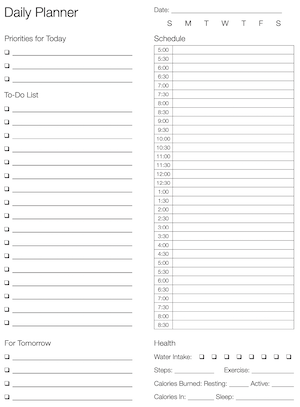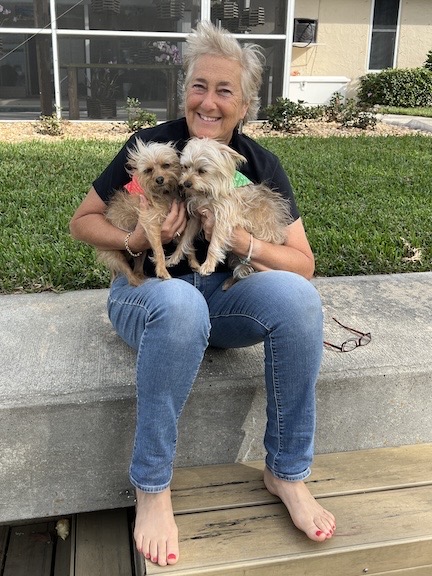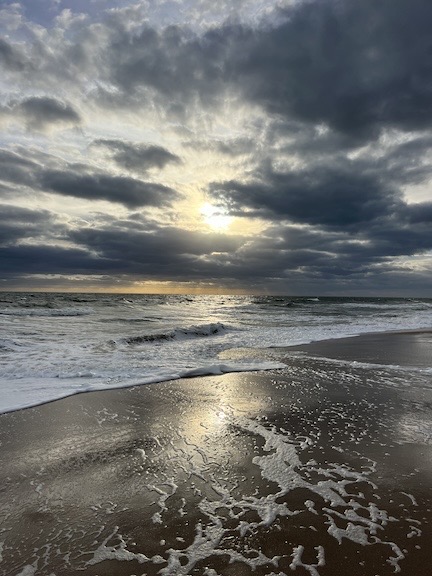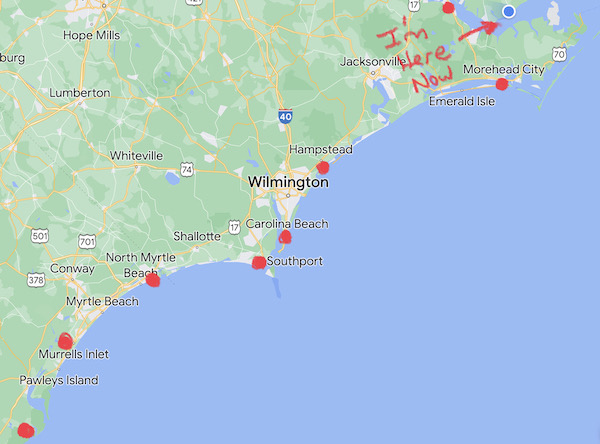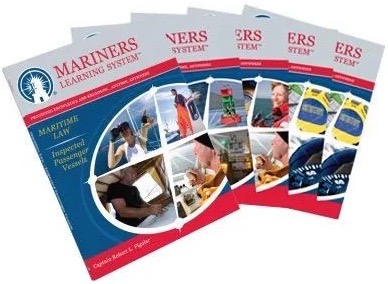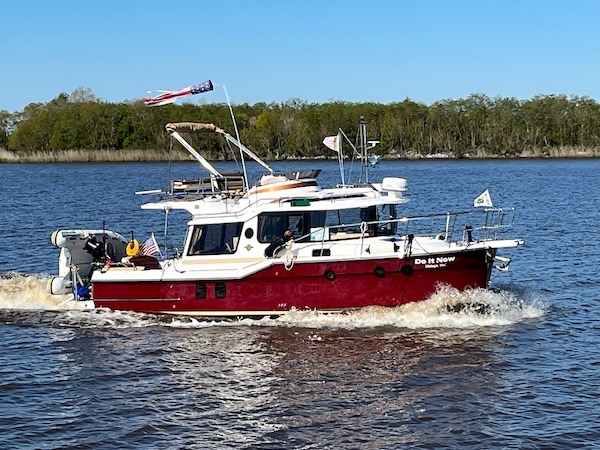A chat with a fellow boater starts me thinking about the importance of independency.
[Note: I wrote this post at least two weeks ago and, when I was done, I decided not to publish it. I thought it might be a bit too self-serving. But then I had an exchange with another user on Mastodon today, after my (solo, of course) cruise across Lake Michigan. You can see a screen grab of the exchange below. I decided that it was very much related to the rest of the content in this post — the elephant in the room, so to speak — so I decided to add it and publish the whole damn thing. – ML]
Lately, I’ve been meeting a lot of people on my Great Loop trip — more people than I’d met on my journeys down the inland waterways and up the ICW. People are going out of their way to meet me and chat with me. Most of them are impressed that I’ve been doing the trip (mostly) alone. These people are invariably couples and they are blown away by what they consider an amazing achievement.
A Rockstar? I don’t think so.
But it all came to a head yesterday when I was in a restaurant in Killarney, ON and a couple at a nearby table called me over as I was leaving.
They recognized my boat by its name and had seen me on it. Apparently, there’s some talk going around about me among the other Great Loop cruisers. A woman doing the Loop alone!
The wife of this couple told me I was a “rockstar” among the Loopers. That’s pretty hard to believe, since I don’t participate in any of the online forums most Loopers are drawn to. But okay, I’ll take it.
Cruising the Great Loop as a Learning Experience
We chatted for a while about cruising and the Loop and the percentage of people who jump into this 6000+ mile journey with little or no boating experience. The husband of this couple had boating experience similar to mine before buying his current boat, a Mainship: growing up around small boats and owning a few throughout his life.
But there are far too many people who start the Great Loop with little or no boating experience on a boat that’s brand new to them. Some folks even sell their boats as they’re finishing up the Loop but continue to cruise to the end, looking forward to the day they can be done and leave their boat for good. I find that mind-boggling.
I met a couple along the Trent-Severn Waterway who had begun their cruise near St. Louis and claimed they “felt done” by the time they were in Florida — not even 1/4 way through the trip! They were selling their boat the day I met them, but wouldn’t turn it over to the new owner until they got to St. Louis moths later. I’m still trying to figure out why they continued a trip they apparently weren’t enjoying. This is pleasure boating, folks; it shouldn’t feel like a chore or an ordeal.
We talked about how much experience a boater can get from a Great Loop trip — that’s actually the number one reason why this trip has meant so much to me. Simply said, it’s made me a good boat captain. How can it not? Navigating more than 7500 nautical miles (so far) on rivers, lakes (including Great Lakes), canals, the Gulf of Mexico, the Intracoastal Waterways, and the Atlantic Ocean. Dealing with locks, bridges, other boaters, and marinas. Cruising in weather from severe clear and calm to thunderstorms with hail. Resolving minor (fortunately) mechanical issues, like losing a stern thruster or having a bilge pump that won’t operate automatically. Having to find and make good stops to refuel, buy groceries, get water, dump garbage, refill propane tanks, and do laundry.
How can all this not make you a better boat captain and all around long distance cruiser?
Determination?
And then one of them said, “You must be pretty determined to do this trip by yourself.”
For a moment, I didn’t know what to say. I never thought of myself being determined to cruise the Great Loop. I just saw it as the boating world equivalent of a classic road trip, like cruising Route 66 or driving up the California Coast. I thought about the experience of visiting all the places along the way, seeing how people live, checking out the local history, eating the local foods. I thought about the challenges of planning and navigating a course, dealing with weather, and living the confined space of a boat. I thought that a boat trip that somehow started and ended in the same place without backtracking would be a great adventure — before I even knew the Great Loop existed.
The Great Loop has never been a “bucket list” item for me, something I can brag about to friends. I’m not going to hang a gold flag sold by a for-profit “club” that exists solely to separate cruisers from their money. Heck, most of my friends don’t know what the Great Loop is and, if they’re not boaters, they don’t really care.
So have I been “determined” to finish the Great Loop? For me, the goal isn’t the achievement of “crossing my wake.” It’s the journey and what I can take away from it to make me a better person.
The Solo Aspect

Here’s the exchange I had with another Mastodon user today that sums up my thoughts on the “female aspect” of my situation, which, frankly, I’m pretty fucking sick of dealing with. Read it to understand why.
It’s the solo aspect that everyone seems to focus on. This conversation really brought that point home to me.
Honestly, I don’t think that doing this trip solo is a big deal. In so many ways, I think it’s better than doing it with a companion. Not only do I get to make all of the decisions — and change my mind as often as I want to — but I don’t have to deal with the pet peeves we all develop when traveling with someone else.
I like to travel alone. I’ve been doing it since the 1980s in my first corporate job and, even when I had a “life partner,” I often made trips by myself. So there’s no part of traveling alone that’s unusual to me. It’s traveling with a companion that’s odd and somewhat difficult at times.
Yes, there are additional challenges when you’re driving a boat by yourself. There’s no one else to handle the lines or put down the fenders when docking or sit at the helm while you take a pee or make a sandwich. (And no one to make a sandwich for you.)
But can’t we all rise to the challenge? Having to deal with fenders and lines while docking alone has forced me to learn how to control my boat in confined spaces — I’m basically forced to get the boat up next to the dock at a near standstill so I can step off with a line and secure it. (There is no jumping on the dock from my boat and very little tossing lines to strangers, since half of them don’t know what they’re doing.) Having no one around to take the wheel when nature calls has taught me a few tricks for leaving the helm briefly while under way without dropping an anchor. And when I know I have a long cruise ahead of me, I make lunch in the morning, before I leave, so all I have to do is fetch it out of the fridge.
It’s problem solving. How do you do the work of two people when you’re just one person? You find ways to make it work. That’s part of the challenge of cruising. That’s part of what makes it interesting to me.
And let’s be real: having a second person aboard who doesn’t know or care about helping out when “needed” is worse than being alone on board. (I’ve been in that situation and it sucks.)
The other question I get a lot is about whether I get lonely. The answer, for the most part, is no. I’ve been alone for so much of my life that I’m used to it. I keep busy. I don’t have time to be lonely. The only thing that makes me a little sad is that I can’t share this incredible adventure with someone I can talk to about it in the years to come.
I’m not the only solo cruiser out there
I also want to mention here that I am not the only person doing this trip solo. Nagui, who I met while cruising last year, completed the loop solo in his Rosborough, Boundless.
I’ve also met Matt on Seaview, Ed on Freedom, Mark on Brandywine, Michelle on Plan B, Chris on Brown Eyed Girl, Bob on Bayleaf, and Harry on a homebuilt sailboat whose name I can’t remember. (Get boat cards, folks!) My apologies to the folks I missed in this list. While not all of these people might be “doing the Loop,” they are all on long-term cruises that require them to do everything that needs doing.
Independence > Dependence
Meanwhile, I feel bad for the folks who think they can’t go it alone. The people who depend on the company of someone else to do things.
I’m not just talking about cruising, either. I’m talking about the things we do in everyday life: dining out, going to the movies, attending live events (do you know how easy it is to get an excellent seat for concerts and shows when you’re a party of one?), traveling, and participating in social activities that may include mostly couples. If you’re single and think you can’t do the things you want to do by yourself, why the hell not? Why depend on the presence or moral support of another person when you’re perfectly capable of doing things on your own? Be independent!
And the only thing worse than feeling as if you can’t do things alone is feeling that you can’t do anything without the partner you might already have, someone who simply doesn’t want to do anything you want to do. Been there, done that! Got a ball and chain? Cut it loose! Live the life you want on your terms.
The End is Near
My trip is coming to an end. I’ll be done in less than a month now. Yesterday, I spent a few hours planning the rest of my route and the stops along the way. I wanted to make sure I could finish it on time — I created a deadline when I bought plane tickets to get home. Unless there’s some crazy bad weather ahead of me when I hit Lake Michigan, I should be fine, with a handful of days to spare in case I need to change plans.
I’ve already planned my next two cruises when I get back to the Pacific Northwest. First, I’ll attend the Ranger Rendezvous, which I first attended the day after I took delivery of Do It Now in September 2022. And then I’ll join a flotilla of boats to cruise up to Desolation Sound and back in late September. There’s a chance a friend will join me for that trip, but I’m not sure right now whether I want company.
And then I’ll let Do It Now get some rest in my garage while I enjoy the comforts of my “dirt home” for a while.
I live there solo, too, and I love it.

